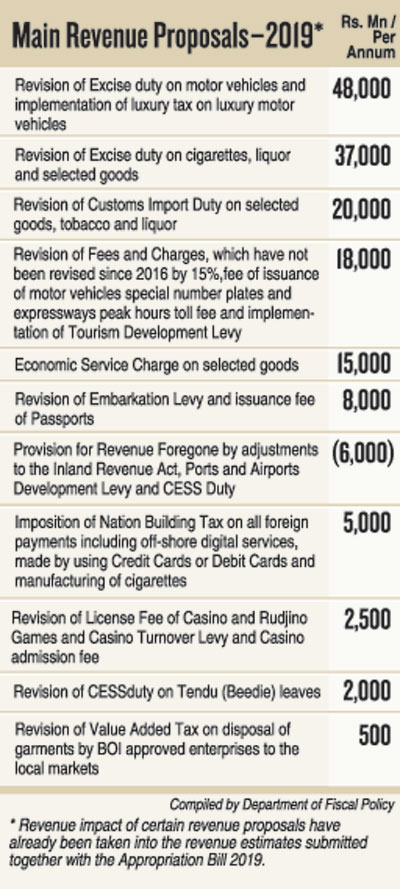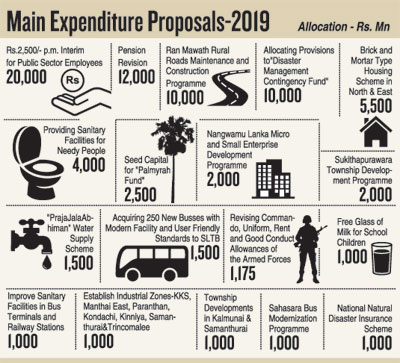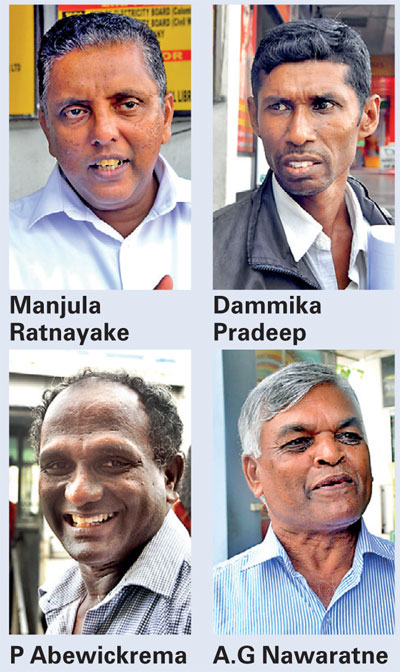News
Mangala’s proposals seen through wary eyes
Budget 2019 was touted as people-friendly, with various relief packages and loans proposed, but the reaction from trade unionists and people have been far less enthusiastic.
Finance Minister Mangala Samaraweera, in his budget titled, “Enterprise Sri Lanka – Empowering the People and Nurturing the Poor,” proposed lending a helping hand to people to help themselves.
 But much of the discontent since Tuesday has been over a seeming failure to address the cost of living. While state employees have been promised a Rs 2500 allowance, that too will only be effective from July 1, meaning that it will be credited at the end of that month. Many of the taxes and other increases though, will go into effect much earlier.
But much of the discontent since Tuesday has been over a seeming failure to address the cost of living. While state employees have been promised a Rs 2500 allowance, that too will only be effective from July 1, meaning that it will be credited at the end of that month. Many of the taxes and other increases though, will go into effect much earlier.
At a time when rice growers are unable to get a fair price, farmer organisations have voiced strong displeasure over what they claim is a lethargic attitude from the government regarding solutions to their issues.
“They have allocated money to sterilise street dogs, but have ignored the farmers,” charged Namal Karunaratne, National Organizer of the All Island Farmers Federation.
“The government can impose a fair price for paddy through a budget proposal and at least allocate some money for farmers who did not get an insurance fee for crop damage due to the drought the previous year,” the AIFF organiser said.
Potato farmers and cattle herders who sell their produce to government institutes have also been neglected, he added.
Education sector proposals were also being criticised for giving priority to private education.
Prof. Rohan Fernando, President of the Federation of University Teachers’ Association (FUTA), recalled a lengthy trade union campaign in 2012 aimed at getting the government to allocate at least 6% of Gross Domestic Product to education.
“Our slogan at the time was, ‘Save State Education.’ We won an agreement from authorities to increase the allocation gradually. However, what has happened is that the government is spending more on non-state education,” he lamented.
While a loan scheme was proposed to enable studies at non-state universities, the FUTA president stressed that those in state universities were also finding it difficult. The Mahapola Scholarship remains at Rs 5,000, while there has been no increase in student bursaries.
The General Secretary of the Ceylon Teachers’ Union, Joseph Stalin, too, objected to the loans for students to study at non-state universities, claiming that it was against “the principle of free education.”
He said that the Rs 200 million allocation should be used to develop state universities and increase the intake.
Mr Stalin was also sceptical about the proposal to provide a glass of milk to students of government schools.
“We hear about this in practically every budget. But, I have never seen students offered dairy milk even at well-recognised schools.”
He, however, praised the proposal to launch an educational scholarship that allows top performers to study at leading international universities, though acknowledging he was not sure if this was just another “election gimmick’’.
The Inter University Student’s Federation’s (IUSF) newly-appointed convener, Maheel Bandara Dehideniya, said more funds should be given to state universities instead of promoting private ones.
“We are allocating a large portion of money for national security though we don’t have a war, yet are unable to spend on education which is a right and requirement of all students. We are against promoting privatised universities and putting a price on free education,” he said.
The budget proposes to support three-wheeler drivers through loans to upgrade to electric three-wheelers and small eco-friendly cars.
The President of the All Island Three-Wheeler Drivers’ Association, Lalith Dharmasekara, said that this was something the industry had been trying to achieve for about 7-8 years. But, there are unresolved issues. 
“The problem is with the battery. Specific issues have still not been addressed, such as how to charge them, how to replace the batteries if they are damaged, and whether the batteries are adequate.’’
Nothing was said about how three-wheeler drivers should dispose of their vehicles before buying electric ones.
“If they want us to dispose of the three-wheelers, they should have a method where the government buys them on the basis that we buy electric three-wheelers with the money we get from the sale.’’
The General Secretary of the Government Management Assistants’ Officer Union, (previously the Government Clerical Service Union), S. S. Attanayake, said that the proposed Rs 2,500 is not satisfactory.
The previous Rs 10,000 proposal for state sector employees was an allowance, not a salary increase.
An Rs. 2,500 salary increase would have bumped up pension benefits and this would have been welcome, he added.
Having discussed disparities in pensions owing to two different Public Administration Circulars, revisions to the pension schemes were made and the anomaly addressed through the budget.
Accordingly, 585,000 pensioners are to be affected by these revisions, with lower grade employees’ pensions to increase by at least Rs 1,600 per month. A Grade 1 teacher will have an increase of Rs 4,600 per month and the pension of a secretary to a ministry will rise by Rs 12,000. This is applicable to individuals who completed 25 years of service and retired before December 31, 2015.
Convener of the Employees Centre for Protecting Pensions, Dhammika Munasinghe, said the budget proposal would solve the anomaly that arose because of the two Public Administration Circulars.
Still, a bigger issue remained.
“Neither this budget, nor the budgets before this, have stated the details of the pension schemes of employees who joined the public service after 2016.”
Pensions of public sector employees who are yet to retire (who joined the service after 2016) too have not been discussed.’’
He stressed that this is a far greater issue than the anomaly addressed in the budget.
| Dreams of better lives dashed Many of those the Sunday Times spoke to lamented that their hopes for relief had been dashed.
An electrician, Dammika Pradeep Jagodarachchi from Kelaniya, said although there is talk of empowering university students, the Government has not increased allocations to universities. He also questioned the rationale of loans such as the ‘Home Sweet Home’ plan for newlyweds, noting that when governments change, the interest on loans will increase. “The government is trying to deceive people by offering loans, instead of benefits.” Rajagiriya resident, Sunny Arambage, complained that the cost of living has not been reduced. The monthly fuel price changes and periodic increase in gas prices, mean monthly increases in prices of essential items. Pensioner, A.G Nawaratne, told the Sunday Times that he was waiting to the buy a vehicle after recently-retiring from the Electricity Board, but that his dream was short-lived as taxes were increased. The government claims it will control the number of vehicles in the country, but taxes have not made a dent in vehicle sales, he said. Housewife, K. Mayadunne, from Sapugaskanda, said that although Mr Samaraweera proposed loans, he did not mention any concessions for household items. People expected prices of essential household goods to be reduced. Some however commended some of the proposals. Teacher, P Abewickrema, said that though salaries have not increased, he is happy about taxes on branded liquor as that makes it unaffordable for school children. Meanwhile, the All-Island Bus Passengers’ Union also praised the proposals to increase production tax and taxes on luxury vehicles. The union said tax revenue should be used to improve public transport. | |
| Billions for projects Several billions of rupees have been allocated in the budget for projects, the government says will “empower’’ the people. Billions have been made available in particular, for two flagship projects, “Gamperaliya,” Rapid Rural Development Project, and “Enterprise Sri Lanka” Credit Programme. The multi-pronged “Gamperaliya” promises to uplift villages by addressing critical infrastructure needs. A total of Rs 48 billion has been allocated. For agriculture and plantation sectors, Rs 12 billion was earmarked. This includes Wayamba Maha Ela, Minipe, and North Central Province canals, which are expected to facilitate the movement of water from the Moragahakanda Reservoir to water scarce regions, ensuring cultivation of Yala and the Maha seasons. Priority has also been given for housing, including for low income groups in urban, rural and estate sectors as well as the North and East. The government intends to achieve this mainly through the Urban Re-generation Project and Model Village Programme, for which Rs 24.5 billion has been allocated. So far, Rs 4.5 billion has been allocated to build 15,000 brick and mortar houses in the Northern and Eastern Provinces. These will begin this year. A further Rs 5.5 billion has been allocated for these initiatives. An important project is to provide sanitary facilities to some 260,000 households. These facilities are to be built in two years. Rs 4 billion has been set aside for this. There are major allocations for education, with Rs 32 billion set aside for the programme aimed at ensuring “13 years of education” for every child. The funds will be used to improve laboratories, class rooms, libraries, sanitary and water facilities, and teachers’ quarters, etc. For universities, Rs 25 billion was allocated for building theatres, professorial units, departmental complexes, libraries and canteens. A 38 percent increase in funding was proposed for the health sector to improve infrastructure at hospitals and other facilities. A total of Rs 24.75 billion has been allocated. Rs 10 billion was proposed to the “Ran Mawath” programme to maintain and build rural roads. A further Rs 20 billion was set aside for public sector salary increases, with a Rs 2,500 interim allowance a month for public sector workers from July 1. Rs 12 billion was allocated to rectify anomalies in the pensions of public sector employees. Many loan schemes were proposed for various groups, including women. Concessionary loans will be provided to the private sector to establish child-care facilities. A “Home Sweet Home” loan scheme will be available for newlyweds to buy, or build, a home. And for migrant workers, a “Sihina Maliga” loan was proposed. Another loan, “My Future” is for undergraduate education at non-state universities |


 Manjula Ratnayake, 49, an employee of a private export company, said there is no strategic planning in the budget. There are no benefits to people, he said. “Though Sri Lanka depends on agriculture, there is no mention about it in the budget. Farmers who had high expectations are facing difficulties,” he said.
Manjula Ratnayake, 49, an employee of a private export company, said there is no strategic planning in the budget. There are no benefits to people, he said. “Though Sri Lanka depends on agriculture, there is no mention about it in the budget. Farmers who had high expectations are facing difficulties,” he said.